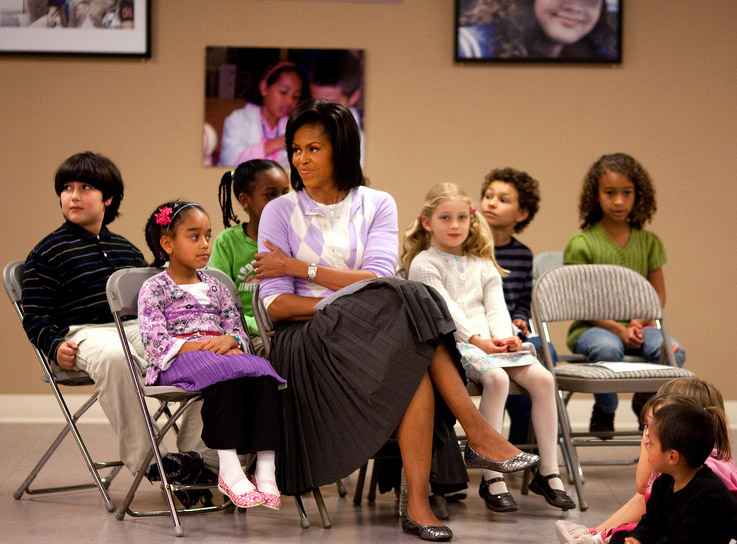Michelle Obama kicked off her campaign against childhood obesity today. Among the provisions are a revamping of the school lunch program, a small boost in funding for farmers markets, a major initiative to “end” food deserts by 2017, a focus on maintaining children’s exercise levels, a set of broad public-private partnerships, along with reforms to front-of-package nutrition labeling and the food pyramid (see the Washington Post‘s Jane Black for a good summary).
But the most intriguing element may have been the creation of The Presidential Task Force on Childhood Obesity. According to the White House blog:
The new task force is charged with developing an interagency action plan to solve the problem of obesity among our Nation’s children as part of the First Lady’s Let’s Move campaign. The campaign will take a comprehensive approach to engage both public and private sectors to help children become more active and eat healthier within a generation, so that children born today will reach adulthood at a healthy weight.
Members of the task force include: the Secretary of the Interior; the Secretary of Agriculture; Secretary of Health and Human Services; Secretary of Education; Director of the Office of Management and Budget; Assistant to the President and Chief of Staff to the First Lady; Assistant to the President for Economic Policy; and heads of other executive departments, agencies, or offices as the Chair may designate.
By their nature, food policy councils are designed to circumvent the parochial interests and often “captured” status of regulatory agencies. By making people who don’t normally talk sit together and consider the broader impact of their policies, food policy councils have the potential to keep special interests from dominating policy debates.
Most state-level food policy councils, such as New York’s or Iowa’s (created by then Gov. Tom Vilsack), include nutrition and access to health food as their core mission. And many find themselves moving towards involvement in local food and expansion of farmers markets and the like as a result of the inevitable conclusion that food production and food access are inexorably linked.
The President’s Task Force on Childhood Obesity is headlined by the two top food-related stakeholders in Health and Human Services — which includes the Food and Drug Administration, the National Institutes of Health and the Centers for Disease Control — and the United States Department of Agriculture. Very interesting to me is the inclusion of the Secretary of the Interior. Most of Sec. Ken Salazar’s purview involves the nation’s natural resources and wildlife management (including grazing practices and fisheries) — that suggests the president is indeed taking a broad view for the mandate of the task force.
And while we don’t know the exact lineup of the task force, note the reference to the inclusion of “heads of other executive departments, agencies, or offices as the Chair may designate” which gives the task force discretion to add representatives from other agencies as desired. I would, for example, urge the president to include EPA Administrator Lisa Jackson on the task force. Even just from the perspective of childhood obesity, toxic chemicals clearly play some role and their top regulator should be part of this effort.
This announcement couldn’t be more timely. Just last week, the Institute of Agricultural and Trade Policy released a paper called “Beyond the USDA: How other government agencies can support a healthier, more sustainable food system” [PDF]. The paper analyzes the role over a dozen different federal agencies play in our food system — the point being that an over-emphasis on the goings on at the USDA risks losing sight of the many opportunities for food system reform that might come from greater inter-agency cooperation. The paper concludes with a call for the president to convene a food policy council. Well, he kinda just did.
Now this new task force isn’t exactly what the IATP was talking about, but it certainly contains the seeds of something greater than was perhaps intended. The fact is that whatever changes the Task Force on Childhood Obesity proposes, we all stand to benefit from improved access to healthy foods and a greater focus on how food policy can affect our health.
In the end, if I were to point to one potentially transformative element of the First Lady’s new anti-obesity campaign — the “game-changer” — this new task force may be it. I hope the First Lady and the president realize the significance of what they’ve done and have the commitment to give the task force real authority to make change.


